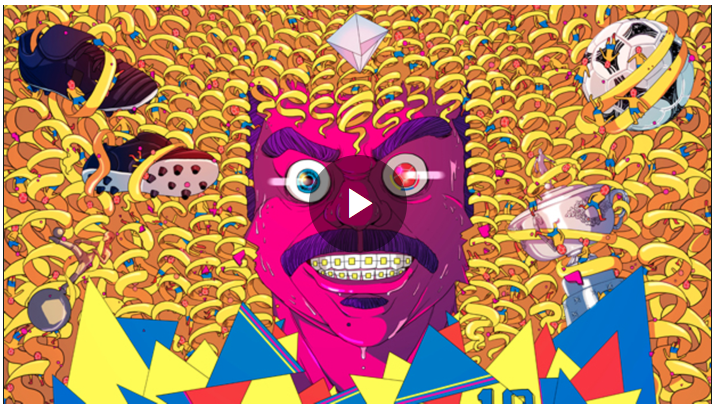El Pibe, MVP
The biggest star in MLS in 1996 was The Kid from Colombia. Carlos Valderrama, the two-time South American player of the year and 1987 Copa America MVP, was already 34 years old by the time the first MLS season kicked off and was entering the twilight of his career. But the ravages of time didn’t really affect Valderrama much because Valderrama didn’t do much running. He had nine other guys who’d do that for him.
If you care about soccer at all, you should take eight minutes to watch this mini-documentary from a few years back:
Valderrama was the sun and the other guys were the nine planets that orbited him. That included future USMNT World Cup star Frankie Hejduk, the great Steve Ralston – still second all-time on the MLS assists chart – and the Big Dog himself, Roy Lassiter.
Tampa Bay’s gameplan in 1996 was simple: 1) Get the ball to Pibe, 2) Lassiter makes his run, 3) through-ball, 4) hope it’s all onside. Often it wasn’t, as Lassiter was offside a staggering 70 times in 1996, the third-highest single-season total in MLS history. But often it was, as Lassiter scored 27 goals, a league record that would stand for 22 years (Chris Wondolowski in 2012 and Bradley Wright-Phillips in 2014 matched Lassiter’s total) until Josef Martinez’s 2018 season.
Tampa Bay’s gameplan was also effective, as they were easily the best team in the regular season with 58 points, nine points better than the second-place Galaxy. Technically that won them the Supporters’ Shield, though that wasn’t actually awarded until a few years later because the Shield did not technically exist until after the 1998 season.
But yeah, I’m not diminishing the other players or the work of head coach Thomas Rongen when I say no player in MLS history has more completely defined a given team’s style than Pibe, who was the alpha and omega of the 1996 Mutiny and absolutely deserving of the first-ever league MVP award. He walks, they run, they score, they win. It was brilliant and beautiful and unlike anything resembling modern soccer.
The closest thing to modern soccer was found elsewhere in the Eastern Conference…

mlssoccer.com
El Pibe, MVP
La estrella más grande en la MLS en 1996 fue The Kid de Colombia. Carlos Valderrama, el dos veces jugador sudamericano del año y MVP de la Copa América de 1987, ya tenía 34 años cuando comenzó la primera temporada de la MLS y estaba entrando en el ocaso de su carrera. Pero los estragos del tiempo realmente no afectaron mucho a Valderrama porque Valderrama no corría mucho. Tenía otros nueve tipos que harían eso por él.
Si te importa el fútbol, deberías tomarte ocho minutos para ver este mini documental de hace unos años:
Valderrama era el sol y los otros tipos eran los nueve planetas que lo orbitaban. Eso incluyó a la futura estrella de la Copa Mundial de USMNT Frankie Hejduk, el gran Steve Ralston, que sigue siendo el segundo en la lista de asistencias de la MLS, y el propio Big Dog, Roy Lassiter.
El plan de juego de Tampa Bay en 1996 era simple: 1) Llevar la pelota a Pibe, 2) Lassiter corre, 3) a través de la pelota, 4) espero que todo esté en juego. A menudo no fue así, ya que Lassiter estuvo fuera de juego 70 veces en 1996, el tercer total más alto de una temporada en la historia de la MLS. Pero a menudo fue, ya que Lassiter anotó 27 goles, un récord de la liga que se mantendría durante 22 años (Chris Wondolowski en 2012 y Bradley Wright-Phillips en 2014 igualaron el total de Lassiter) hasta la temporada 2018 de Josef Martinez.
El plan de juego de Tampa Bay también fue efectivo, ya que fueron fácilmente el mejor equipo en la temporada regular con 58 puntos, nueve puntos mejor que el Galaxy en segundo lugar. Técnicamente eso les ganó el Escudo de los partidarios, aunque en realidad no fue otorgado hasta unos años más tarde porque el Escudo técnicamente no existía hasta después de la temporada 1998.
Pero sí, no estoy disminuyendo a los otros jugadores o el trabajo del entrenador en jefe Thomas Rongen cuando digo que ningún jugador en la historia de la MLS ha definido más completamente el estilo de un equipo dado que Pibe, que era el alfa y omega del Motín de 1996 y absolutamente merecedor del primer premio MVP de la liga. Él camina, corren, marcan, ganan. Era brillante y hermoso y diferente a cualquier cosa que se pareciera al fútbol moderno.
Lo más parecido al fútbol moderno se encontró en otros lugares de la Conferencia Este …


